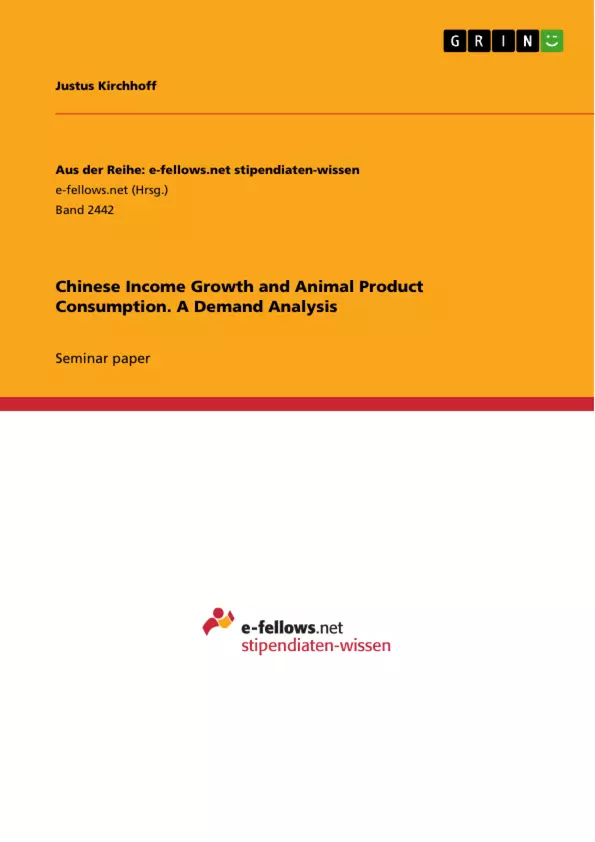In this study, National Bureau of Statistics of China (NBS) data from 1995 to 2012 was used to investigate the link between growing income and rising animal foods demand in China. Due to China’s population size, the latter has implications for mankind on a global scale, ranging from the acceleration of climate change to the exacerbation of health risks and threats to food security. It is therefore vital to understand to what extent the increasing prosperity of the world’s most populous country connects to higher demand for animal products.
Two approaches were chosen to compute income elasticities: an OLS estimator and an Almost Ideal Demand System (AIDS), which lead to significantly different results. The AIDS model produced more reliable estimates, indicating a rise of poultry consumption parallel to increasing income, a rising share of income being spent on aquatic products, and decreasing demand for eggs for urban households. Due to the lack of out-of-home consumption data, these results likely understate the real demand.
Inhaltsverzeichnis (Table of Contents)
- Introduction
- Review of Relevant Literature
- Literature on China
- Worldwide Perspective
- Statistics on China
- Data and Methods
- Results and Discussion
- Conclusion
Zielsetzung und Themenschwerpunkte (Objectives and Key Themes)
This study examines the link between increasing income and growing demand for animal products in China from 1995 to 2012. The research aims to understand the income elasticities of different animal foods, analyze how they differ between rural and urban households, and investigate their evolution over time. The study's findings will contribute to predicting future animal food consumption based on income data, allowing for clearer estimations of the environmental challenges and health risks associated with animal product consumption, thus informing policy decisions.
- The relationship between income growth and animal food consumption in China.
- Income elasticities of different animal foods in China.
- Differences in income elasticities between rural and urban households.
- Evolution of income elasticities over time.
- The implications of animal product consumption on environmental challenges and health risks.
Zusammenfassung der Kapitel (Chapter Summaries)
The introduction chapter provides an overview of the study's objectives, research questions, and its relevance in light of the global challenges associated with animal product consumption. It highlights China's significant contribution to these challenges due to its economic growth and large population.
The second chapter reviews relevant literature on animal product consumption in China, worldwide, and relevant statistics on China. This chapter provides a foundation for the study by discussing previous research on the relationship between income and animal product consumption, both within China and globally.
The data and methods chapter details the data used in the study, which includes National Bureau of Statistics of China (NBS) data from 1995 to 2012. The chapter also explains the two econometric methods employed: an OLS estimator and an Almost Ideal Demand System (AIDS).
The results and discussion chapter presents the findings of the study, focusing on the estimated income elasticities of different animal foods and their variations across rural and urban households. The chapter likely also explores the evolution of these elasticities over time.
Schlüsselwörter (Keywords)
This study focuses on the relationship between income growth and animal product consumption in China. It analyzes income elasticities, differentiates between rural and urban households, and explores the evolution of these relationships over time. Key topics include animal product consumption, income growth, demand analysis, income elasticities, rural and urban households, climate change, food security, and health risks.
- Quote paper
- Justus Kirchhoff (Author), 2017, Chinese Income Growth and Animal Product Consumption. A Demand Analysis, Munich, GRIN Verlag, https://www.grin.com/document/371178



